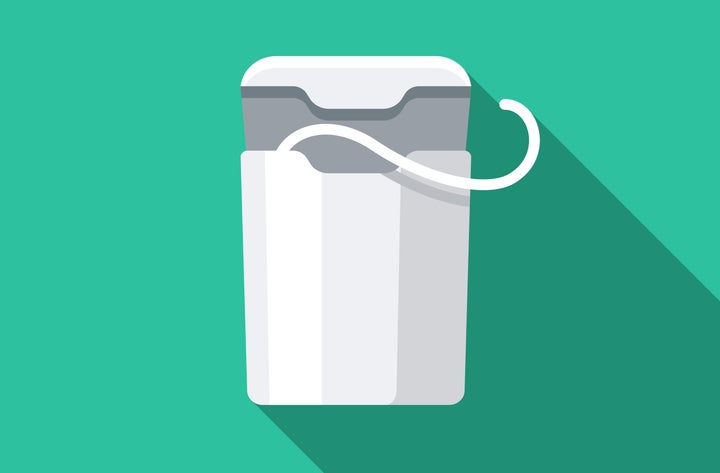You sit in the dentist’s chair, look up at the bright white light and get the same old question for the umpteenth time: do you floss? (And no, we’re not talking about the dance).
An investigation by Associated Press (AP) in 2016 found there was little scientific evidence to suggest flossing is beneficial – despite it being recommended across the board, from dentists as well as the NHS.
Four years after AP’s findings, which saw the US government quietly update its guidelines to remove recommendations to floss on its website, UK dentists are standing by what they said: flossing, or using interdental brushes, daily is good for our teeth.
Specialist orthodontist and member of the British Dental Association, Dr Iain Hoeltschi, tells HuffPost UK: “Even though there has been conflicting evidence about flossing and its effectiveness, I still thoroughly recommend flossing once a day. I also recommend using interdental brushes as these are better equipped to remove food particles and bacteria that can build up between teeth.”

Why should you floss?
While the evidence base is inconclusive for flossing, that doesn’t mean you shouldn’t do it, says Professor Damien Walmsley, the British Dental Association’s scientific adviser.
Flossing helps you reach areas of the tooth that toothbrushes can’t. Often, bits of food may come out from between your teeth when you floss, which would otherwise be left. “You wouldn’t wash only one side of a dirty dish and then put it back in the cupboard to use again tomorrow, would you?” says Dr Reena Wadia, a gum specialist.
When you brush, she explains, you’re only washing half of the surfaces of your teeth – front and back – and you’re neglecting the sides your toothbrush doesn’t touch. This leaves the area near the gum line dirty, “like only washing one side of a dish.”
If left uncleaned, plaque can build up between the teeth, and the bacteria in it can cause gum disease. A 2017 study, which came after the AP investigation, found flossing was associated with a “modestly lower” prevalence of periodontitis (inflammation of the gums and structures of the teeth). Out of 6,939 adults, the odds of periodontitis were 17% lower for those who flossed more than once a week than for those who flossed less often. The study suggested flossing between two and four days a week could be as beneficial as flossing more frequently. But dental experts tell HuffPost UK that daily is best.
Interdental brushes should be your first choice if these fit in between your teeth, adds Dr Wadia. This advice is echoed by NHS Choices, too. “[The brushes] come in various sizes and you need to ensure a snug fit so go for the largest size that fits. If the interdental brushes don’t fit, floss is your next best option.”
What happens if you don’t floss?
Dr Hoeltschi and Dr Rhona Eskander, a member of the British Dental Association, say they visibly see the difference between patients who floss and those who don’t. “The biggest sign to tell if someone flosses or not is in their gums,” says Dr Hoeltschi. “Regular flossing leads to healthier gums, whereas people who don’t floss can have slightly red and inflamed gums.”
Dr Eskander says other tell-tale signs of non-flossers are patients with plaque between their teeth, bleeding gums and bad breath, as a result of “trapped food and proliferating bacterial growth” between their teeth.

Should you floss before or after brushing?
The order you floss and brush could make a difference, according to a small study of 25 dental students from 2018. Floss first, brush second was found to be better than brushing then flossing in order to reduce interdental plaque.
Dr Eskander, who advises her patients to floss twice a day, agrees that people should floss before they brush. “This then ‘unplugs’ the gaps and makes the brushing more effective as the brush tips can reach between the teeth more readily,” she explains. “It also allows for an easier flow of mouth wash which can reach areas of the teeth which bristles tips can’t.”
Are there any negative implications to consider?
The environment, for one – tooth floss is a single-use plastic that is typically made of nylon or Teflon, which isn’t biodegradable. And because it doesn’t break down, it can cause serious clogs and environmental damage when flushed. But there are alternative options, such as plastic-free charcoal floss made from bamboo trees.
Flossing could also damage your gums if you do it too vigorously. Dr Hoeltschi says if you notice severe bleeding or pain after flossing, visit your dentist for advice.
The routine can also be hard to follow for people who aren’t very dextrous, who have large hands or arthritis, says Dr Eskander. If you find flossing difficult, try interdental brushes (such as Tepe), or an electronic flossing device (such as the Philips AirFloss), she suggests.
What else can be done to practice good teeth hygiene?
Professor Walmsley, from the British Dental Association, urges people to brush teeth twice a day with a fluoride toothpaste. His warning comes after a survey of adults’ oral health in the UK revealed that around one in four only brush their teeth once a day.
Ultimately, other ways you can reduce your risk of tooth decay and gum disease is to brush your teeth twice a day with a fluoride toothpaste, see the dentist regularly, cut back on sugar and keep your sweet treats to meal times.